An abdominoplasty (commonly referred to as a Tummy Tuck) removes excess skin and fat from the abdominal area and repairs separated abdominal muscles to restore a flatter, firmer and more youthful abdominal profile. This is done by separating the skin from the abdominal wall, repairing abdominal muscle widening, and then pulling down and repositioning the skin to create a smoother appearance.
The SixSurgery team offers both the traditional tummy tuck and the extended tummy tuck, but what sets us apart from other clinics is our drain-free technique. This is a new and improved surgical technique that does not require a drain during the recovery period. We also take special care to position our incisions very low on the abdomen so that they are well hidden within the bikini line, and patients come to our clinic after appreciating this detail in our results. Contrary to popular belief, Tummy Tucks are not just for those post-pregnancy but for anyone with loose abdominal skin.
Discover real patients just like you. Discover real patients just like you. Discover real patients just like you.
After significant weight loss, there is only so much that diet and exercise can do to achieve a flat tummy. A tummy tuck, or abdominoplasty, is designed to remove that excess fat and sagging skin and tighten separated abdominal muscles in a way that exercise is not able to do. This helps patients regain a smooth and flat abdominal profile, leading to increased confidence and comfort in clothing.
A tummy tuck, however, is NOT a weight loss surgery nor is it able to remove fat deposited deep within your intra-abdominal cavity. If your belly is large and feels very tight, with little loose skin, you most likely need to lose weight before you can have a tummy tuck.

Pregnancy left this woman with excessively stretched abdominal muscles, to a point where they were unable to maintain a normal abdominal contour and the internal organs were protruding forward making her look pregnant. A tummy tuck tightened her skin and repaired her muscles, restoring her core strength and a flatter tummy.

This 50 year old patient underwent an abdominoplasty. During her tummy tuck she had 1465g of skin and fat removed, 3200cc of fat liposuctioned from the upper abdomen and love handles, and her muscles which were stretched out by her prior pregnancies have been repaired. Her after photo is taken 3 months after surgery.
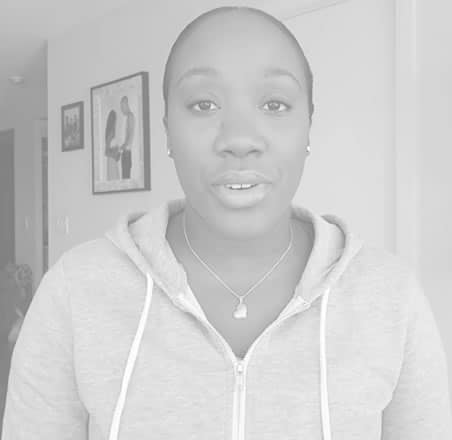
A drain free tummy tuck is a surgical technique that was developed by the SixSurgery team to improve the results of a traditional tummy tuck procedure. The differentiating feature of a drain free tummy tuck, is that our surgeons do not use surgical drains at the incision site, and you will not need to have drains after the surgery. A traditional tummy tuck will require you to wear a drain for at least a week after surgery.
A drain free tummy tuck provides patients with a faster recovery, less discomfort, and a lower and a better concealed scar that is thinner than one found in a traditional tummy tuck. During the surgery advanced techniques and tools such as quill sutures and anesthetic blocks are used to improve the final contour, reduce complications like seroma, and help keep you comfortable after your surgery.
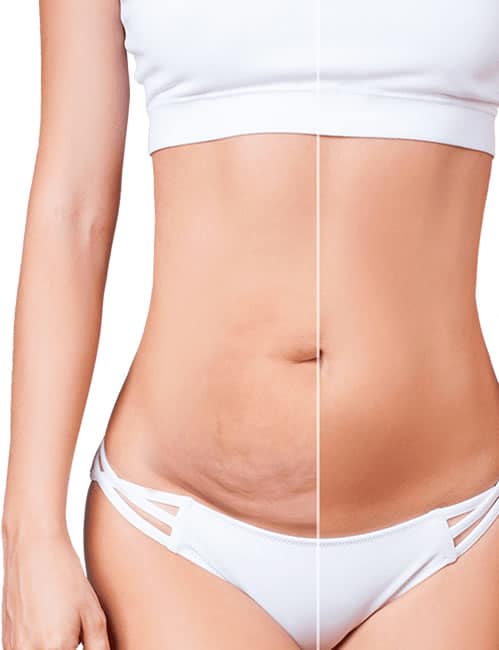
Our patients include men and women who lost weight and are left with loose abdominal skin, mothers who after childbirth have stretched abdominal muscles, and others who despite their best efforts in the gym can’t get rid of that belly pouch.
If you have an abundance of loose or excess skin on your abdomen, or have an excessive amount of external abdominal fat (fat that you can grab and pinch with your hands), you may be a candidate for tummy tuck surgery. In addition, most mothers have some amount of abdominal muscle stretching or muscle laxity due to childbirth. If you find you have one of these issues, or all three, a tummy tuck is the ideal way to correct these problems.
If you can pinch a large section of loose, sagging skin on your stomach, or you are are constantly bothered by the feeling that your stomach is too large, a tummy tuck may be the appropriate procedure for you. However, if you only have minimal excess skin and little weakness in the abdominal wall, you may be a candidate for a “mini” tummy tuck. The SixSurgery team will determine which procedure is best for you during your initial consultation.
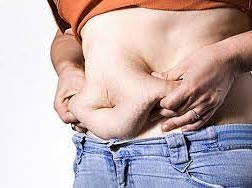
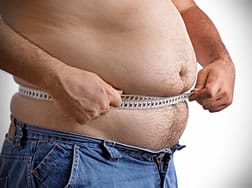
The patient on the left has a lot of loose skin that can be easily pinched and grabbed. That is an ideal candidate for a tummy tuck.
The patient on the right has a large belly that feels full and tight. It protrudes out a lot. If you try to push into it, it feels relatively hard. There is not a lot of loose skin you can grab, as you can in the other photo. This person is NOT a candidate for a tummy tuck and must lose weight before being considered. If a tummy tuck is done at this stage, it will do little to improve the appearance of that belly.
When seeking a tummy tuck, brazilian butt lift, or liposuction of the abdominal area, it is important to be able to differentiate between the internal fat and the external fat. Internal fat (visceral fat) is the fat contained within the abdominal cavity (the body cavity which contains the stomach, liver, intestines – vital digestive organs) and is closely wrapped around your internal organs. External fat (subcutaneous fat) is the fat that is under your skin and can be removed via liposuction or cutting out during surgery.
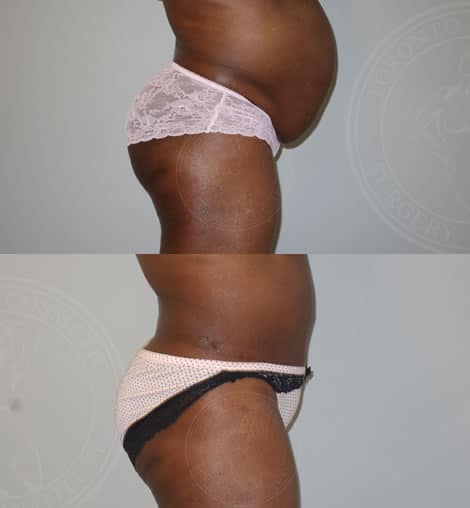
The above image shows a patient who underwent a tummy tuck while still having a significant amount of external fat. In this situation, although she shows a very nice improvement, she still has a protruding abdomen and this will not be corrected until she loses more weight (internal fat)
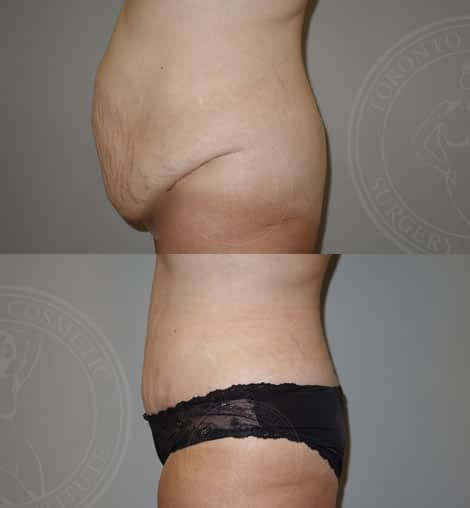
This is another patient with higher BMI who has a significant amount of internal fat. A tummy tuck removed the excess skin hanging off her abdomen, but it cannot flatten the belly or make her ‘thinner’. Internal fat (fat within the abdominal cavity, visceral fat) is removed only via diet and exercise.
For a person without medical training, it may be impossible to differentiate internal and external fat when looking at a human body. Two people may look similar, may appear to have the same bulging belly and love handles. But because of their different fat distribution, they would get two very different results after a body contouring plastic surgery.
Internal fat is the fat within the abdominal cavity. A ‘beer belly’ would be the most extreme example of this, where a large belly is very protruding, feels very hard, and all the fat (visible volume) is internal. Because this internal fat is closely wrapped around the digestive organs, any attempt at liposuctioning or cutting it out would damage these organs and potentially lead to death. For this reason, internal fat is not removed. If you have a large amount of internal fat, the only way to remove it is via diet and exercise. For morbidly obese patients, bariatric surgery such as gastric bypass, gastric sleeve, lap band, or other procedures that limit you ability to intake calories may lead to weight loss.
External fat is the fat that is under your skin. It is not wrapped around any vital organs, so liposuction and cutting it out is possible. This is the ONLY type of fat that a Plastic Surgeon can sculpt, shape, or remove.
Pinch it. If you can pinch it, you can likely treat it with plastic surgery. When you do pinch, however, realize that you are pinching a layer of fat that is folded over (see the video on this page) therefore in effect the real fat thickness is half of the pinch thickness.
There are several different types of abdominoplasty, and the SixSurgery team will help determine which option is best for you. This decision is made based on the amount of loose skin, excess fat and laxity of the stomach muscles. Different techniques include:
A standard tummy tuck allows both the upper and lower abdomen to be tightened and contoured, and allows for complete repair of the abdominal muscles. In this procedure, an incision is made above the pubic hairline, another is made around the belly button, and the muscles that run vertically on each side of the stomach’s front wall are tightened. The skin removal and the muscle tightening are the most critical steps in improving the contour of the stomach. Liposuction may be performed along with the complete tummy tuck, depending on the amount of fat that needs to be removed.
A mini tummy tuck is done for patients who have minimal excess skin in the lower abdomen only, and no considerable weakness in the abdominal wall.
An Extended abdominoplasty is recommended for patients with a larger amount of loose skin that extends to the sides of the abdomen. This technique is most often recommended for patients who have lost a significant amount of weight and have a lot of loose skin.
For patients with a large amount of excess skin and fat in the back and hip area as well as the abdomen, a circumferential abdominoplasty can be considered. This is a more involved procedure and can help to improve body contour in three dimensions.
Following an abdominoplasty bruising and swelling is to be expected, which will diminish over a period of one to two weeks. Because patients retain some water following the procedure, there will be some temporary weight gain. This is normal, and will dissipate quickly.
Recovery from tummy tuck surgery requires rest and taking it easy. The first two days following the surgery are usually the most uncomfortable. After the first two days you’ll notice a dramatic improvement in how you feel. Because of the innovative surgical techniques by SixSurgery, your discomfort will be easily controlled with prescription medication only.
During your recovery you should avoid strenuous physical activity; this is especially important if your abdominal muscles have been repaired from diastasis recti. You may need to limit your physical activity from four to six weeks.
After your tummy tuck procedure, you will have a flatter, firmer abdominal contour that is proportionate with your individual body type and weight. The actual results will be hidden due to swelling at first, but you will begin to see your new slimmer profile within one to two weeks after surgery. Depending on the surgery, it may take anywhere from several weeks or months to see the final results.
During recovery it is critical that you refrain from smoking. Smoking deprives your body of oxygen, which increases the risk of wound breakdown and infection following the surgery.
The goal of a tummy tuck is to provide you with a tighter, smoother and more toned abdomen.
For the best results, ensure you have all your post-surgery supplies: compression binders, gels, dressing, absorbent pads, and foams. Order high quality tummy tuck recovery kits from Recovery Market.
Choosing a cosmetic surgery procedure is always an important decision that should never be rushed. At SixSurgery we always takes the time to get to know our patients and their individual reasons for wanting a Tummy Tuck. During this consultation, you will have a general health check and discuss all the risks and benefits of an abdominoplasty. This is also a time when you can ask any questions that you might have about Tummy Tuck surgery in a private, but friendly clinic environment.
Some patients may have excessive amounts of internal fat which cannot be corrected by Plastic Surgery. If your BMI is over 30 or the SixSurgery team determines you have excess internal fat and would benefit from weight loss prior to your tummy tuck, you will be asked to lose a certain amount of weight before we can proceed with your surgery. As you can see in the above photo, our patient underwent weight loss prior to her surgery and her final result is beautiful. This would not have been possible without her losing excess intra-abdominal fat (via diet and exercise).

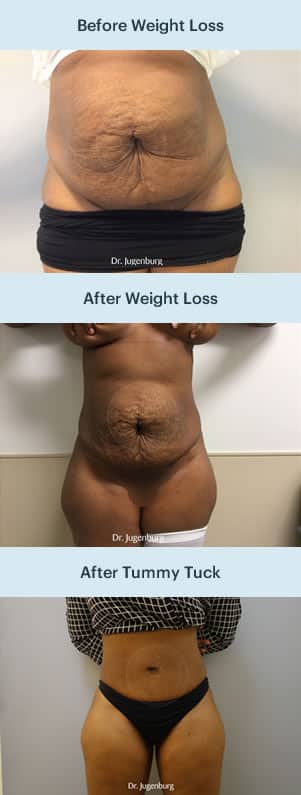
The best way to determine if a tummy tuck is the right procedure for you is to have an initial consultation with our SixSurgery Consultation expert. You will have an opportunity to discuss your goals and expectations with the team, and ask any relevant questions you have about the surgery.
The SixSurgery team will listen to your needs, expectations, and your desired outcome from the surgery. We will review all the surgical options that are available to you, and you will be able to tour our state-of-the-art facility and meet with our caring staff that will be part of your team.
The tummy tuck surgery will be performed in our certified and accredited medical facility located inside the luxurious Royal York Hotel., Tummy tucks generally take anywhere from 2 to 3 hours. The length of your surgery will depend on your body type and the amount of work that is required.
The procedure begins a with general anesthesia. You will be completely asleep during the surgery.
In a traditional tummy tuck, an incision is made horizontally in the area between the public hairline and the belly button. The amount of excess skin will determine the length of the incision.
The skin will be dissected up toward the rib cage, the muscles are tightened and the belly button is repositioned while excess skin is removed. This helps to dramatically improve the appearance and strength of the abdominal area. The SixSurgery team may recommend having liposuction along with the tummy tuck to provide optimal results.

After the excess fat and skin are removed, the remaining skin from the upper abdomen is released and pulled down over the open area to close it. After the muscles are tightened the skin is contoured to the new, flat abdominal shape.
Once the procedure is completed, the incision will be sutured and bandaged. You may be given an elastic bandage or compression garment to wear in order to minimize swelling to support the abdomen as it heals.
Following your surgery you will recover in one of the beautiful Fairmont Royal York Hotel rooms. You will receive a care package from us and our staff is available to you while you stay with us. Should you desire, full room service is available to you.
You will see our SixSurgery nurses the day after your procedure and at specified intervals during the weeks following your surgery. This is done so that your surgeon can personally monitor your recovery process, and to ensure that you have the best results possible.
Muscle repair (repair of rectus diastasis) that takes place during a tummy tuck repositions separated abdominal muscles which were stretched and separated during a pregnancy. In mild cases of rectus diastasis, abdominal workouts and physio may be helpful. However with more significant muscle separation no amount of sit ups, physio, diet or exercise will correct the separation. In such patients, surgical muscle repair (diastasis repair) is the only effective treatment.

Abdominal rectus muscles have been stretched during her pregnancy, and a tummy tuck was used to tighten her abdominal muscles, skin and flatten the belly.

Another example of a muscle repair and removal of some excess skin left after a pregnancy. No amount of sit-ups can repair this damage, unfortunately.
There are many differences between a mini tummy tuck and a full tummy tuck. The main difference is that with a mini tummy tuck the area at and above the navel is not treated, so there is no scar or repositioning of the belly button. Other differences include:
| Differences | Mini Tummy Tuck | Tummy Tuck |
|---|---|---|
| Goal: | Goal: Remove loose skin in the lower abdomen only |
Goal: Treat muscle separation above and below the navel; remove excess skin above and below the belly button. |
| Procedure: | Procedure: Incision above the pubic bone. Excess fat is removed; skin is tightened. Muscles are not tightened. |
Procedure: The surgeon elevates skin to the top of the abdomen, repairs abdominal separation, and creates a flat contour from the top of the abdomen down to the pubic bone, removing all excess tissue. |
| Suitable for: | Suitable for: Those with a minimal amount of loose skin in the lower abdomen only. |
Suitable for: Most patients with stretched skin from multiple pregnancies or weight loss, and any considerable muscle separation. |
| Anaesthesia: | Anaesthesia: General anesthesia or local with sedation |
Anaesthesia: General |
| Scarring: | Scarring: Slightly shorter scar |
Scarring: Longer scar from hip bone to hip bone |
| Recovery: | Recovery: 2-3 weeks |
Recovery: 4-6 weeks |
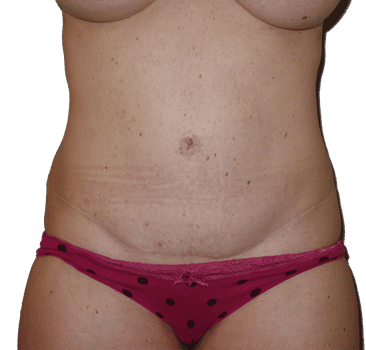
A full tummy tuck involves a scar that typically runs from hip to hip. We make every effort to keep the scar as low as possible so that when you wear your pants or a bikini, the scar is hidden. There is also a scar around the belly button. A mini tummy tuck does not have a belly button scar.
These scars take several months to fade, and a year to fully mature.
Can the scar be shorter? The tummy tuck scar length varies in length from patient to patient. The length is determined by your existing fold and how much loose skin you have. If you look in a mirror and see the fold where your skin folds over, this can help estimate the extent of your scar. Trying to cheat and make the incision shorter results in unnatural looking folds/lumps on at the sides of the incision and insufficient removal of loose skin. If you are unsure about how long your scar would be, you can always send us your picture for an assessment.
While the tummy tuck, or abdominoplasty, is designed to create an abdominal profile that is smoother and firmer, an alternative procedure is a panniculectomy. This is NOT a tummy tuck, this is an ‘amputation’ of the loose skin in patients who have lost >100lb and have medical problems due to the excessive skin. This is NOT a cosmetic procedure and the goal of surgery is not to improve appearance. This procedure can be performed alone or in combination with a tummy tuck, and is done to remove the skin hanging on the abdomen, called the “pannus” or apron. It runs from below the belly button, and is usually a result of losing significant amounts of weight – approximately 100 pounds or more. It is often done at the same time as the tummy tuck.
While the tummy tuck tightens the underlying stomach muscles, the panniculectomy only removes the excess skin and fat required for medical reasons.
Patients requiring panniculectomy have overcome obesity and have recently lost a significant amount of weight. They also may have post-pregnancy problems with excessive fat that is situated below the belly button. Depending on the amount of excess skin you have and the condition of your abdomen, your surgeon will determine the best procedure or procedures to meet your specific needs.
(additional liposuction: $ 2500 – $ 6500 per additional area to be liposuctioned)
per additional area to be liposuctioned – please note liposuction fees differ greatly depending on the area and and expected volume of liposuction)
(when added to liposuction or BBL)
(when added to liposuction or BBL)
(when added to liposuction or BBL) (already includes VASER fee) PLEASE NOTE BMI Requirement must be UNDER 25
Avoid any vigorous exercise, heavy lifting, or the gym for 6 weeks after the surgery. Failure to do so will lead to loss of muscle repair, and abdominal bulging (throughout the entire abdomen, around the belly button, or in the upper or lower abdominal area), Although complications following Abdominoplasty are infrequent; the following may occur:
Bleeding, which in rare instances could require hospitalization and blood transfusion. Blood clots may form under the skin and require drainage.
Skin irregularities, lumpiness, hardness and dimpling may result; some problems disappear with time and from massage, other problems may persist and additional treatments may be necessary
Infection is rare but may occur and treatment with antibiotics and/or drainage may be required. In rare instances surgery may be required for severe infection (such as necrotizing fasciitis.)
Wound dehiscence (wound opening) may occur and is generally allowed to heal on its own. This may be related to loss of blood supply to the skin (skin necrosis).
Outpatient nursing may be required to assist with the wound care. You may be required to travel to a local clinic for daily wound care.
Hernia may be found during the surgery and may require surgical repair, which may be associated with potential injury to the bowel.
Numbness of the skin over treated areas is common and can persist for months. In rare cases it may be permanent.
Abnormal scarring or scar position is rare but is possible.
Dizziness may occur during the first week following Abdominoplasty surgery particularly upon rising from a lying or sitting position. If this occurs, extreme caution may be exercised while walking. Do not drive a car if dizziness is present.
Deep Venous Thrombosis, Pulmonary Embolism and Fat Embolism may occur.
Abdominal perforation may also occur in rare instances.
The risk of these specific complications is increased in patients with increased BMI and previous abdominal surgeries. If left untreated these complications may be fatal.
One of the possible complications after a tummy tuck is skin necrosis in the midline, as that has the poorest blood perfusion after a tummy tuck. If this happens, the management is to allow the area to heal and once fully healed, your SixSurgeon will then come back and perform a reconstruction using a tissue expander. This will be used to stretch the normal uninjured skin to allow for the reconstruction.
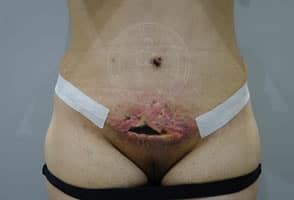
A patient after a tummy tuck, suffering from skin necrosis in the midline. This area will be treated conservatively and allowed to heal before a reconstruction is possible.
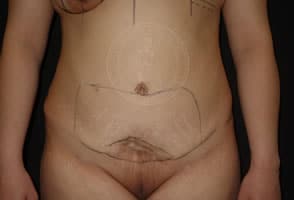
The necrotic area seen after it has completely healed. You also can see markings outlining the area of the skin that will be stretched out to help reconstruct the defect
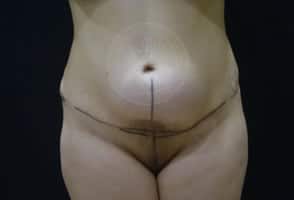
Patient seen with a tissue expander in place, stretching the good skin
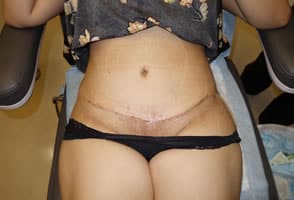
Abdominal wall defect reconstruction with tissue expansion. Patient is seen here shortly after reconstruction
A typical consultation takes about 30 minutes. During this process, you will have a chance to tell us about your goals, and we will examine you. Please note that some patients have predominantly internal fat which makes them poor candidates for a tummy tuck. Our team may require you to lose weight before you can undergo a tummy tuck.
After the initial incision is made, excess skin and fat will be removed, and if the patient is a candidate for muscle repair, the abdominal muscles will be tightened. The remaining skin from the upper abdomen is released and pulled down over the open area to close it. A new belly button opening is made and the existing belly button is then pulled to the surface. The tummy skin will appear tighter and more flat. The incision is then sutured, and bandages are applied.
You will notice improvement immediately after your surgery. As the swelling subsides over the next several weeks, the results of the procedure will be in full effect. Final results are best appreciated at 3 months and the scars will evolve over 1 year.
This varies from patient to patient. If you have a job that requires physical exertion, you may have to wait from 2-4 weeks to return to work after surgery. The SixSurgery team will discuss this with you during your consultation.
If you maintain a healthy lifestyle that includes a healthy diet and regular exercise, the results you obtain with your abdominoplasty should remain for a long time. Please remember that no cosmetic surgery procedure is a permanent solution, as your body will continue to age.
We recommend that patients should wait to have a tummy tuck until after they are finished having children, as this will help to both maximize and prolong the results achieved with the procedure.
Abdominoplasty is often combined with other procedures, such as breast augmentation, breast lift, breast reduction and liposuction. Having these procedures at the same time as a tummy tuck can help avoid multiple surgeries. Please be sure to inform our team that you are interested in multiple procedures before your consultation, so we can allocate the proper amount of time to discuss each one.
At our clinic, we recommend having these procedures done separately as recovery for both a BBL and a tummy tuck at the same time is very difficult and often compromises one of the results.
Because of the innovative surgical techniques used by the SixSurgery team, you will have less discomfort, a lower and better concealed scar and a scar that is thinner than one found in a traditional tummy tuck.
Light exercise can begin within about 6 weeks. More strenuous exercise involving the abdominal muscles, including sit ups, can usually begin within 12 weeks after your surgery.